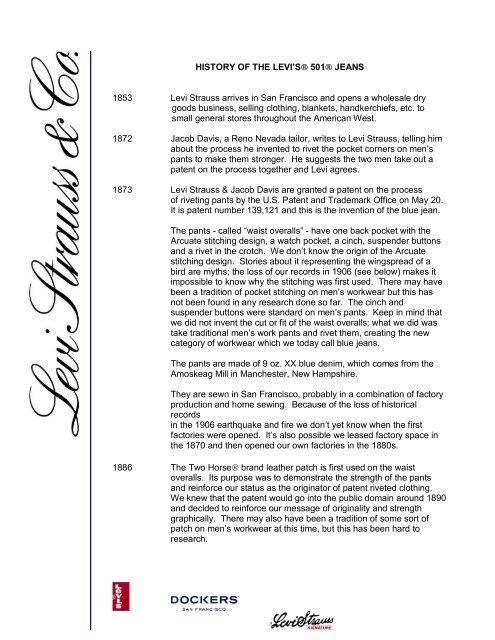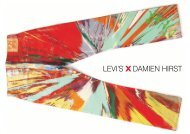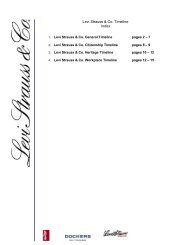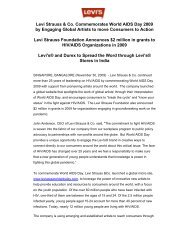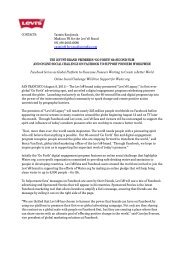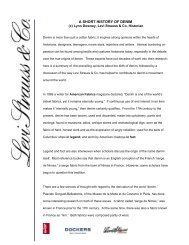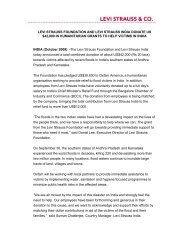A history of Levi's® 501® jeans - Levi Strauss & Co.
A history of Levi's® 501® jeans - Levi Strauss & Co.
A history of Levi's® 501® jeans - Levi Strauss & Co.
Create successful ePaper yourself
Turn your PDF publications into a flip-book with our unique Google optimized e-Paper software.
HISTORY OF THE LEVI’S® 501® JEANS1853 <strong>Levi</strong> <strong>Strauss</strong> arrives in San Francisco and opens a wholesale drygoods business, selling clothing, blankets, handkerchiefs, etc. tosmall general stores throughout the American West.1872 Jacob Davis, a Reno Nevada tailor, writes to <strong>Levi</strong> <strong>Strauss</strong>, telling himabout the process he invented to rivet the pocket corners on men’spants to make them stronger. He suggests the two men take out apatent on the process together and <strong>Levi</strong> agrees.1873 <strong>Levi</strong> <strong>Strauss</strong> & Jacob Davis are granted a patent on the process<strong>of</strong> riveting pants by the U.S. Patent and Trademark Office on May 20.It is patent number 139,121 and this is the invention <strong>of</strong> the blue jean.The pants - called “waist overalls” - have one back pocket with theArcuate stitching design, a watch pocket, a cinch, suspender buttonsand a rivet in the crotch. We don’t know the origin <strong>of</strong> the Arcuatestitching design. Stories about it representing the wingspread <strong>of</strong> abird are myths; the loss <strong>of</strong> our records in 1906 (see below) makes itimpossible to know why the stitching was first used. There may havebeen a tradition <strong>of</strong> pocket stitching on men’s workwear but this hasnot been found in any research done so far. The cinch andsuspender buttons were standard on men’s pants. Keep in mind thatwe did not invent the cut or fit <strong>of</strong> the waist overalls; what we did wastake traditional men’s work pants and rivet them, creating the newcategory <strong>of</strong> workwear which we today call blue <strong>jeans</strong>.The pants are made <strong>of</strong> 9 oz. XX blue denim, which comes from theAmoskeag Mill in Manchester, New Hampshire.They are sewn in San Francisco, probably in a combination <strong>of</strong> factoryproduction and home sewing. Because <strong>of</strong> the loss <strong>of</strong> historicalrecordsin the 1906 earthquake and fire we don’t yet know when the firstfactories were opened. It’s also possible we leased factory space inthe 1870 and then opened our own factories in the 1880s.1886 The Two Horse® brand leather patch is first used on the waistoveralls. Its purpose was to demonstrate the strength <strong>of</strong> the pantsand reinforce our status as the originator <strong>of</strong> patent riveted clothing.We knew that the patent would go into the public domain around 1890and decided to reinforce our message <strong>of</strong> originality and strengthgraphically. There may also have been a tradition <strong>of</strong> some sort <strong>of</strong>patch on men’s workwear at this time, but this has been hard toresearch.
c1890The rivet patent goes into the public domain, so that <strong>Levi</strong> <strong>Strauss</strong> & <strong>Co</strong>.is not longer the exclusive manufacturer <strong>of</strong> riveted clothing.Lot numbers are first assigned to the products being manufactured. 501®is used to designate the famous copper-riveted waist overalls. We don’tknow why this number was chosen. We also made a 201 jean, whichwas a less expensive version <strong>of</strong> the pants, as well as other productsusing other three-digit numbers. Because <strong>of</strong> the loss <strong>of</strong> our records in1906, the reasons for many <strong>of</strong> these changes are unknown.c1901The pants – now just called “overalls” - now have two back pockets. It’slikely we added this additional pocket due to consumer requests orchanges in men’s fashions at the time.1902 <strong>Levi</strong> <strong>Strauss</strong> dies at the age <strong>of</strong> 73. His nephews take over the business;their descendants still run the company today.1906 The San Francisco earthquake and fire destroys the headquarters andfactories <strong>of</strong> <strong>Levi</strong> <strong>Strauss</strong> & <strong>Co</strong>.A new factory is built at 250 Valencia Street in San Francisco and opensin November.1910sSometime during this decade the <strong>jeans</strong> are sewn with a felled inseam.Prior to this time the inseam was “mock” felled.1915 The overalls win a “Highest Award” at the Panama-PacificInternational Exposition in San Francisco.LS&CO. begins to buy denim from <strong>Co</strong>ne Mills in Greebsboro, NorthCarolina.1922 Belt loops are added to the overalls, but the suspender buttons arestill retained. The cinch is also still used on the pants, but some mencut if <strong>of</strong>f in order to wear the overalls with a belt. Again, the addition<strong>of</strong> belt loops was in response to changes in men’s fashions and ourunderstanding <strong>of</strong> what consumers wanted.LS&CO. now buys its denim exclusively from <strong>Co</strong>ne Mills.c1927<strong>Co</strong>ne Mills develops the 10 oz. red selvage denim exclusively for the501® <strong>jeans</strong>. The denim is woven in 29” wide looms.1936 The red Tab is first placed onto the right back pocket <strong>of</strong> the overalls. Theword “<strong>Levi</strong>’s® is stitched in white in all capital letters on one side only.The Tab is created to differentiate <strong>Levi</strong>’s® overalls from the manycompetitors in the marketplace who were using dark denim and anArcuate stitch. We had not yet trademarked the Arcuate so othercompanies were using it in direct imitation <strong>of</strong> us.
1937 The back pockets on the overalls are sewn so that they coverthe rivets. This is in response to consumers who complained that therivets scratched furniture and saddles.The suspender buttons are removed from the overalls. <strong>Co</strong>nsumers aregiven snap-on buttons in case they still want to wear suspenders.WorldWar IIChanges are made to the overalls in order to conform to rulesset by the War Production Board for the conservation <strong>of</strong> raw materials.The crotch rivet, watch pocket rivets and back cinch are removed to savefabric and metal. The Arcuate stitching design is removed as the thread isdecorative only and not vital to the usefulness <strong>of</strong> the garment. In order tokeep the design on the pants, LS&CO. sewing machine operators paint iton each pair.1943 The Arcuate stitching design is registered as a trademark.c1947Early 1950sThe post-war version <strong>of</strong> the 501® <strong>jeans</strong> starts coming <strong>of</strong>f the productionline. The cinch is gone forever, the rivets are put back on the watchpocket and the Arcuate is now stitched with a double-needle machinewhich gives it the “diamond” shape at the point where the two lines<strong>of</strong> stitching meet. This creates the uniform look <strong>of</strong> the Arcuate, whichis in contrast to previous years, when the single needle applicationgave each Arcuate design a unique appearance, depending on the skill<strong>of</strong> the operator.The word LEVI’S is now stitched on both sides <strong>of</strong> the red Tab. We arenot sure why this was done.1954 A zippered version <strong>of</strong> the overalls is introduced and named 501Z. Thiswas introduced as we had begun selling our products on the East <strong>Co</strong>ast<strong>of</strong> the United States and many people were unfamiliar with the buttonfly.Late 1950sThe leather patch is replaced by a Two Horse patch made <strong>of</strong> heavy-dutycard stock, known as the “leather like.” This is due to the fact that thecompany was selling products nationally, and it was becoming moreexpensive to use real leather. Also, the newer automatic washingmachines were very hard on the real thing.1960 The word “overalls” is replaced by the word “<strong>jeans</strong>” in advertising and onpackaging. We had made other products in the past which we called“<strong>jeans</strong>” (specifically, denim pants for boys in the 1930s) but our top <strong>of</strong> theline “overalls” – 501® <strong>jeans</strong> – did not get this name until teenagers begancalling the product “<strong>jeans</strong>” in the 1950s. No one really knows why theword became associated with the men’s overalls, but teenagers adoptedthe phrase and it became the term used by all manufacturers.c1961Pre-shrunk <strong>Levi</strong>’s® <strong>jeans</strong> are introduced.1964 The <strong>jeans</strong> become part <strong>of</strong> the permanent collections <strong>of</strong> the SmithsonianInstitution in Washington, D.C.
1966 The first television commercial for <strong>Levi</strong>’s® <strong>jeans</strong> is aired.The rivets are removed from the back pockets and replaced withbar tacking. This is due to the fact that the strong rivets eventually worethrough the denim, exposing them and causing the problems that led totheir being covered back in 1937: scratching furniture.1971 The word “<strong>Levi</strong>’s® on the red Tab device is now stitched in whitewith a capital “L” only; the “E” looks like it changed, leading to the vintageclothing concept <strong>of</strong> “Big E” and “little e.” This was done toconform to the company’s new housemark – the “batwing” – which wasadopted in 1967 and in which the word “<strong>Levi</strong>’s” is meant to be the propername <strong>of</strong> our founder, <strong>Levi</strong> <strong>Strauss</strong>.1981 501® <strong>jeans</strong> for women are introduced, with the airing <strong>of</strong> the famous“Travis” television commercial.1983 <strong>Co</strong>ne Mills begins to introduce XXX denim through the use <strong>of</strong> 60” widelooms.1984 The renowned “501 Blues” television advertising campaign is launched atthe summer Olympic Games in Los Angeles.1985 LS&CO. wins the Governor’s <strong>Co</strong>mmittee Media/Advertising Awardfrom the New York State Office <strong>of</strong> Advocates for the Disabled, forits positive portrayals <strong>of</strong> disabled people in the “501 Blues” televisionads.1986 The first in a series <strong>of</strong> innovative television commercials for the 501®<strong>jeans</strong> airs in Europe. These commercials feature classic American rockmusic mixed with nostalgia and romance.1992 Due to the interest in “vintage” <strong>Levi</strong>’s® <strong>jeans</strong> on the part <strong>of</strong> consumersworldwide, LS&CO. introduces the “Capital E” jean in the United States.This also follows on the success <strong>of</strong> the vintage model created earlier by<strong>Levi</strong> <strong>Strauss</strong> Japan.1993 <strong>Levi</strong> <strong>Strauss</strong> & <strong>Co</strong>. sponsors the “Send Them Home Search,” a contest t<strong>of</strong>ind the oldest pair <strong>of</strong> <strong>Levi</strong>’s® <strong>jeans</strong> in the United States. The winningpair dates to the late 1920s.1996 Building on the success <strong>of</strong> the Capital E product, a new series <strong>of</strong> vintagereproductions - called the <strong>Levi</strong>’s® Vintage Clothing line - is introduced instores worldwide.1997 LS&CO. buys a pair <strong>of</strong> c1890 501® <strong>jeans</strong> for $25,000.1998 The <strong>Levi</strong>’s® 501® <strong>jeans</strong> celebrate 125 years <strong>of</strong> originality.2003 LS&CO. celebrates the 130 th anniversary <strong>of</strong> the invention <strong>of</strong> the blue jean.
From the June 28, 1873 issue <strong>of</strong> Pacific Rural Press“A New Pocket Fastening - Mr. J.W. Davis, formerly <strong>of</strong> Reno, Nevada, but nowresiding in this city [San Francisco] has just received through the Scientific Press PatentAgency, letters patent for an improvement in fastening the seams <strong>of</strong> pockets. Theimprovement consists in the employment <strong>of</strong> a metal rivet or eyelet for fastening theseams.“Simple as this device seems, nevertheless it is quite effective, and we do notdoubt that his manufacture, <strong>of</strong> overalls especially, will become quite popular amongst ourworking men, as the overalls are made and cut in the style <strong>of</strong> the best custom made pants.Nothing looks more slouchy in a workman than to see his pockets ripped open andhanging down, and no other part <strong>of</strong> the clothing is so apt to be torn and ripped as thepockets. Besides it slouchy appearance, it is inconvenient and <strong>of</strong>ten results in the personlosing things from his pockets.“<strong>Levi</strong> <strong>Strauss</strong> & <strong>Co</strong>. <strong>of</strong> this city are sole agents for the new manufacture, and willsoon place them in the market in large quantities, so that our miners, farmers andworkingmen can supply themselves with superior overalls.”


